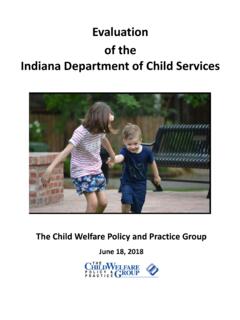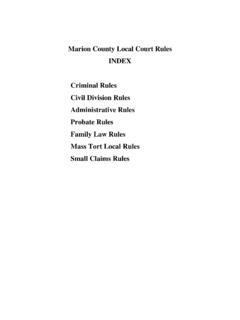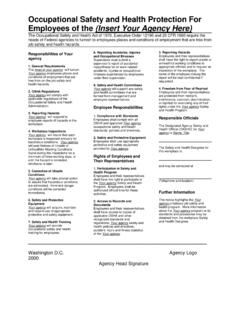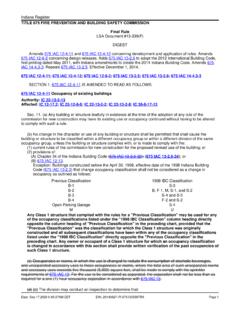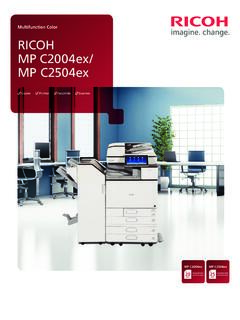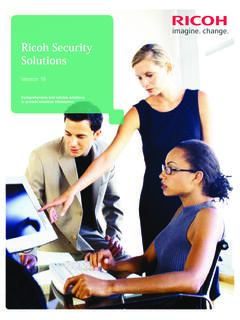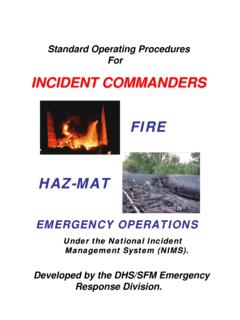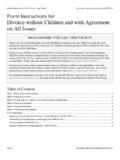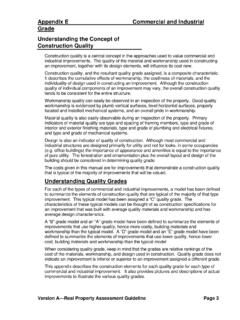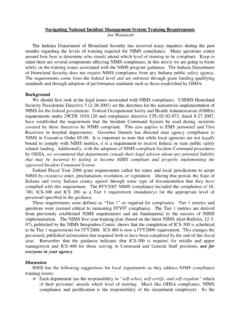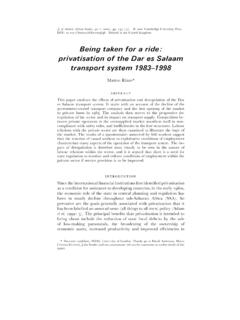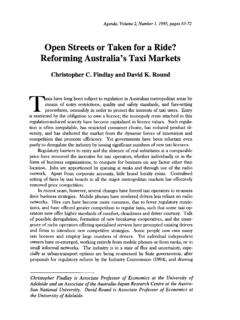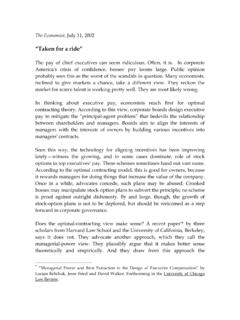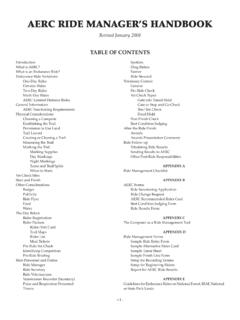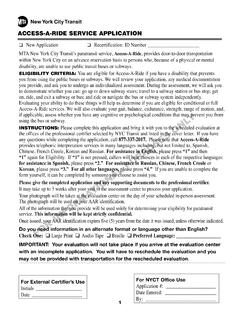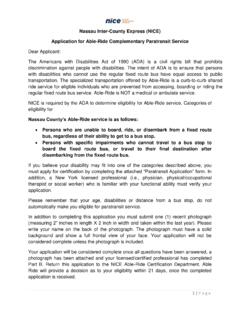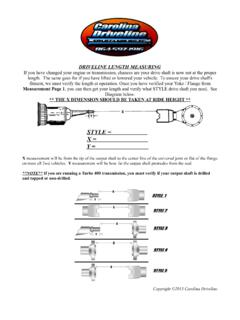Transcription of General Amusement Ride Safety Tips - in.gov
1 CONSUMER Safety General Amusement ride SafetyChild Safety TipsPersons with Disabilities General Amusement ride Safety Tips Read posted rules thoroughly. Follow all height/age restrictions and verbal instructions issued by ride operator's. Read and explain all posted rules to your child(ren) prior to letting your child(ren) ride each ride . Emphasize the importance of following these rules. Keep all body parts (hands, arms, legs, long hair, etc.) inside ride at all times. If you have long hair, put it up (if possible wear a hat or use a band of some sort). Always use the Safety equipment provided (seat belt, shoulder harness, lap bar, chain, etc.). If you believe the device is not properly positioned please revisit the situation with your nearest ride operator.
2 Hold onto handrails, when provided. They're part of the Safety equipment designed to keep you safely in place. Remain in the ride until it comes to a full and complete stop at the unloading point of the ride . If a ride stops temporarily, due to mechanical failure or other reason, stay seated and wait for the ride to start up again or for an operator to give your further instructions. Stop riding before you get excessively tired, to avoid injuries or illnesses. Never ride while under the influence of alcohol or drugs. Don t board a ride if you see broken parts, signs of improper maintenance, or an inattentive operator, you also should listen to the ride (does it sound like a machine in need of repair).
3 You can learn a great deal about a ride and its condition from just looking and listening. While most parks and carnivals pay close attention to ride Safety , there are unfortunate exceptions; just as in any industry. Follow your instincts; if something about a ride seems suspicious, don't ride it. Drink plenty of water while visiting an Amusement facility, especially on a hot day. Wear comfortable clothing and shoes when visiting an Amusement facility. Take frequent breaks. Pay attention to walking surfaces (cracks, holes, elevations, missing grates, etc.) a broken ankle or bone will also hinder a day. If you are a person of extreme size (height or weight) you should pay close attention to all posted signs.
4 If you have difficulty sitting in any seat properly then do not ride that ride and/or device. Participate responsibly, you should be in good health to ride safely. You know your physical conditions and limitations. If you suspect that your health could be at risk for any reason, or you could aggravate a pre-existing condition of any kind by riding a ride and/or device, DO NOT ride ! Child Safety Tips Be a cautious consumer when it comes to kiddie rides. Use sound judgment when selecting an Amusement ride for your child to ride on. Do not put a child on a ride that they may be afraid of. Watch the ride with your child before boarding. Read warning signs aloud and together.
5 Explain the information and ask your child to explain the material back to you. Prior to riding the ride they should understand the warnings fully. Point out the operator and the entrance/exit locations prior to riding. Explain that rides sometimes stop temporarily, but that riders must never get off until the operator tells them to. Talk about what to do if your child gets frightened while the ride is moving. Tell your child NOT to get out of their seat. Explain that Amusement rides might seem scary, but as long as you follow the rules and remain seated until the ride comes to a complete stop at the exit station they should not be in any danger. Tell children to hold on tightly with both hands to lap bars, handholds or any other item designed specifically for hand placement.
6 Always use the Safety equipment provided, but be aware of its limitations. ride manufacturers provide seatbelts, lap bars, and other Safety equipment to reduce the risk of injury. However, many Safety devices used on children's Amusement rides aren't designed to keep young children in their seats. Lap bars on Ferris Wheels and lap ropes on kiddie trains aren't considered restraints at all. They're designed as psychological barriers, an incentive to stay seated. Solid metal lap bars found on some rides only fit closely against the largest passenger in the car, often leaving children with room to slide around. If a lap bar doesn't fit closely, a fast-moving ride can cause a child to slip completely out from underneath the bar.
7 Loose-fitting lap bars also allow young children to stand up on their own while a ride is moving. Obey minimum height, age, and weight restrictions. Never sneak children onto rides that they are too small or too young for. ride manufacturers' restrictions take into account the forces exerted by the ride and (sometimes) the intellectual maturity required to ride safely. A smaller/younger child may not be physically or developmentally able to stay safely seated. Use the posted height and age limits as suggestions, not pass/fail criteria. Manufacturers base their guidelines on developmental timelines and height/weight ratios of children in the 50th percentile. Kids who are tall for their age may not be developmentally ready for a particular ride .
8 Kids who are more impulsive than average need closer parental supervision. Don't put your children on a rides that they have outgrown. Maximum height and weight limits are just as important as minimum limits. If you can t count on your child to stay seated with hands and feet inside, don t let them ride . Watch all extremities; including feet if the ride has open sides. Excited children often stick hands, arms, feet or even their heads out the sides of Amusement rides. Load children to the inside, away from open doorways, or on the side closest to the ride operator (Some rides have very specific rider requirements, follow these requirements as necessary).
9 Pay special attention as the ride slows to a stop. Children who are in a rush to be the first one off, or in a hurry to get to the next ride , may try to exit while the ride is still moving. Parents are much more likely to ride along with their small children at parks which include unlimited rides in the admission price. Carnivals and family entertainment centers usually charge a fee for each ride . The ride owner/operator decides whether to charge parents who accompany their children. In cases where parents don't physically take up a seat, they're often allowed on for free, but not always. Regardless of the ride owner's policy, cost should not determine whether you ride along.
10 Your children are priceless, and it's your job to keep them safe. Adults aren't allowed to ride on some kiddie rides. Some kiddie rides are so small that weight limitations restrict parents from riding. Again, that doesn't mean the hazards have been eliminated. Don't let kids supervise kids on Amusement rides. Talk with your children before they visit Amusement parks or carnivals. Discuss the different kinds of rides: roller coasters, spinning rides, Ferris wheels, etc. Talk about the motion of each ride , and what might happen if riders don't follow the Safety rules. Explain why it's important to obey height and weight limits, both maximums and minimums.
